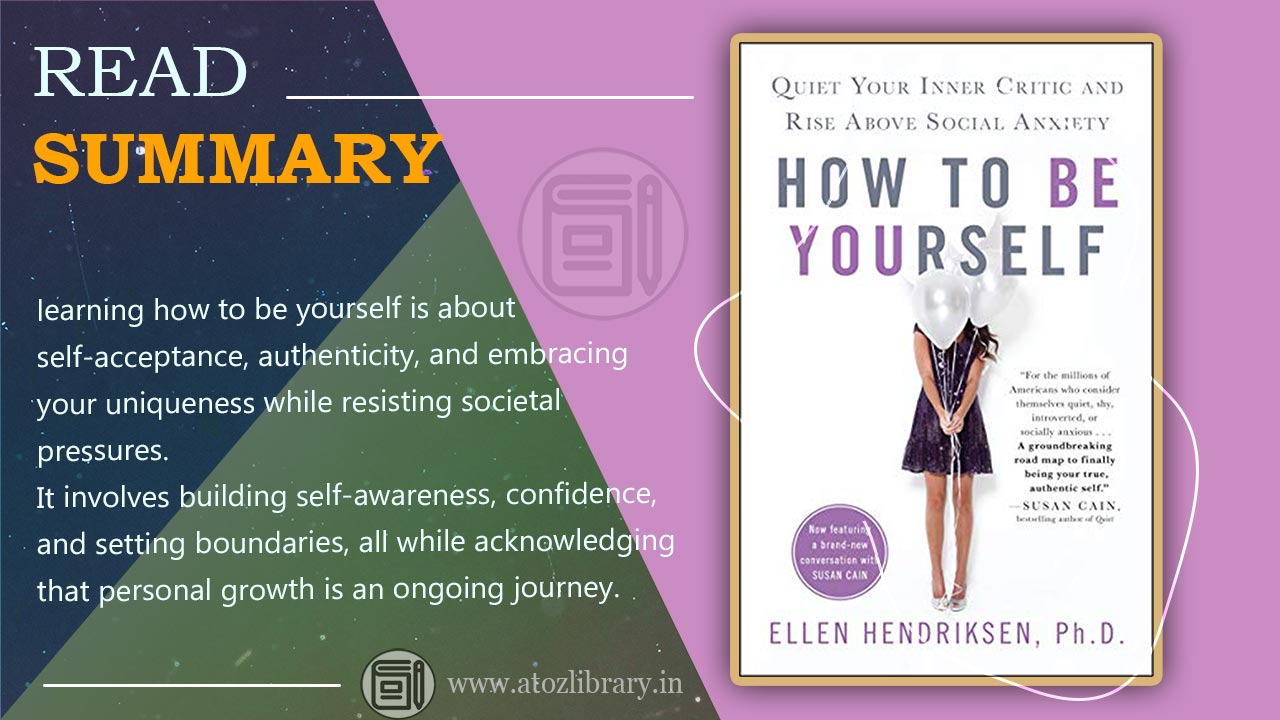Introduction
Ellen Hendriksen’s How To Be Yourself is a guide to breaking free from the chains of social anxiety and embracing the power of authenticity. In this insightful book, Hendriksen, a seasoned clinical psychologist, unravels the complexities of social anxiety, offering practical strategies and empowering insights.
As readers embark on a journey of self-discovery, they’ll find a roadmap to navigate social situations with confidence and overcome the barriers that hinder genuine connection. Let’s dive into the key lessons that can transform self-doubt into self-acceptance, providing readers with the tools they need to be their true, unapologetic selves.”
Understanding the Authentic Self:
Being yourself is a powerful journey of self-discovery and acceptance. Here’s a guide to understanding and embracing your authentic self:
Discover Your Values: Start by identifying what truly matters to you. Your values are like your personal compass, guiding your decisions and actions.
Accept Your Uniqueness: Embrace the fact that you are one-of-a-kind. Your quirks and differences make you special, so celebrate them.
Self-Reflection Matters: Take time to reflect on your thoughts, feelings, and experiences. This self-awareness is key to understanding who you really are.
Listen to Your Intuition: Trust your gut feelings. Your intuition often guides you toward what aligns with your authentic self.
Express Your True Feelings: Don’t be afraid to share your thoughts and emotions. Authenticity involves expressing yourself genuinely.
Set Boundaries: Know your limits and communicate them. Setting boundaries is a way of respecting yourself and others.
Let Go of Expectations: Release the pressure of meeting others’ expectations. Focus on living in a way that feels true to you.
Celebrate Your Achievements: Acknowledge your accomplishments and strengths. Celebrate the small victories on your journey.
Understanding your authentic self is about being true to who you are and living a life that reflects your values and passions. It’s a journey of self-love and acceptance.
The Power of Positive Psychology:
ositive psychology is like a magic wand that can transform your mindset and well-being. Here’s how you can tap into its power:
- Focus on the Good: Instead of dwelling on problems, train your mind to notice the positive aspects of your life. Gratitude can be a game-changer.
- Cultivate a Positive Mindset: Approach challenges with optimism. Believe in your ability to overcome difficulties, and see setbacks as opportunities to learn.
- Practice Self-Compassion: Be kind to yourself, especially when things don’t go as planned. Treat yourself with the same understanding you’d offer to a friend.
- Engage in Positive Activities: Do things that bring you joy and fulfillment. Whether it’s a hobby or spending time with loved ones, prioritize activities that lift your spirits.
- Surround Yourself with Positivity: Build a positive environment. Connect with people who uplift you and create spaces that inspire positive feelings.
- Mindful Living for Positivity: Practice mindfulness to stay present and savor the positive moments in your life. Mindfulness helps reduce stress and increase overall well-being.
- Positive Affirmations: Use positive affirmations to counter negative self-talk. Remind yourself of your strengths and capabilities.
- Celebrate Small Wins: Acknowledge and celebrate your achievements, no matter how small. It fosters a positive mindset and motivates you to keep going.
- Positive psychology is a tool that empowers you to lead a happier and more fulfilling life. By adopting positive habits, you can enhance your overall well-being and outlook on life.
You May Like:- Rich Dad Poor Dad Summary- By Robert Kiyosaki
Social Anxiety: Building Confidence and Connection
Social anxiety can feel overwhelming, but with simple steps, you can overcome it and feel more at ease in social situations:
Understand Social Anxiety:
- Social anxiety is common, and it’s okay to feel nervous. Recognize that many people experience it, and you’re not alone.
Challenge Negative Thoughts:
- Identify and challenge negative thoughts about social situations. Replace them with more positive and realistic thoughts.
Start Small:
- Take small steps to gradually expose yourself to social situations. It could be as simple as saying “hello” to a neighbor or joining a small gathering.
Focus on Others:
- Shift your focus from yourself to others. People are generally more interested in the conversation than scrutinizing your actions.
Practice Social Skills:
- Improve your social skills through practice. This could involve making eye contact, smiling, or initiating conversations.
Use Relaxation Techniques:
Learn relaxation techniques, such as deep breathing, to manage anxiety in social settings. Calming your body can help calm your mind.
Celebrate Social Wins:
- Acknowledge and celebrate your social successes, no matter how small. Positive experiences build confidence over time.
Seek Support:
- Share your feelings with a trusted friend or seek professional help. Supportive connections can make a significant difference.
Remember, overcoming social anxiety is a gradual process, and it’s okay to progress at your own pace. With practice and patience, you can build confidence and enjoy social interactions more comfortably.
Building Confidence: Simple Steps to Believe in Yourself
Confidence is like a muscle that you can strengthen over time. Here are practical tips to boost your self-assurance:
Set Realistic Goals:
Start small and set achievable goals. Celebrate each accomplishment, and gradually challenge yourself with bigger tasks.
Positive Self-Talk:
- Replace negative thoughts with positive affirmations. Be your own cheerleader and remind yourself of your strengths.
Body Language Matters:
Stand tall, make eye contact, and smile. Confident body language not only influences others but also affects how you feel about yourself.
Learn from Mistakes:
- Mistakes are part of life. Instead of dwelling on them, view them as opportunities to learn and grow. Each mistake is a step toward improvement.
Practice, Practice, Practice:
- Whether it’s public speaking or a new skill, practice builds confidence. The more you do something, the more comfortable and confident you become.
Visualize Success:
- Picture yourself succeeding in your endeavors. Visualization can boost your confidence and create a positive mindset.
Accept Compliments Graciously:
- When someone praises you, accept it graciously. Say “thank you” instead of downplaying your achievements.
Surround Yourself with Positivity:
- Spend time with supportive and positive people. Their encouragement can bolster your confidence and belief in yourself.
Remember, confidence is a journey, not a destination. By incorporating these practical tips into your life, you’ll gradually build the confidence needed to tackle challenges and pursue your goals.
You May Like:-Ratan Tata Life Story || Know His Best Strategy for business
Breaking Free from Comparison:
Comparison can be a sneaky thief of joy. Hendriksen suggests a few simple ways to break free from the trap of comparing ourselves to others:
Recognize Your Uniqueness:
Everyone is different, and that’s what makes the world interesting. Embrace your quirks and unique qualities.
Focus on Your Journey:
- Life is a personal journey, not a race against others. Concentrate on your own progress and celebrate your achievements.
Social Media Awareness:
- Social media often showcases only the highlights of people’s lives. Remember, you’re seeing a curated version, not the full story.
Gratitude for What You Have:
- Appreciate what you have accomplished and the positive aspects of your life. Gratitude can shift your focus away from what you lack.
Limit Comparisons to Past Self:
- Instead of comparing yourself to others, compare your current self to your past self. Acknowledge your growth and improvements.
Celebrate Others’ Success:
- Shift from envy to admiration. Celebrate the success of others, recognizing that their achievements don’t diminish your own.
Define Your Own Success:
- Success means different things to different people. Define success on your terms, aligning with your values and aspirations.
Remember, you are a unique individual, and comparing yourself to others only hinders your journey toward authenticity. Celebrate your uniqueness and focus on becoming the best version of yourself.
Setting Boundaries for Self-Care:
Life can get overwhelming, but you can navigate it more smoothly by setting boundaries. Here’s how:
Learn to Say No:
It’s okay to decline things that overwhelm you. Saying “no” is a powerful way to protect your time and energy.
Identify Your Limits:
- Understand what you can handle without feeling stressed or drained. Knowing your limits helps you set realistic boundaries.
Communicate Clearly:
- Express your needs and limits to others. Clear communication helps people understand your boundaries.
Prioritize Self-Care:
- Make time for activities that recharge you, whether it’s reading, taking a walk, or simply relaxing. Prioritize self-care without feeling guilty.
Create Physical and Emotional Space:
- Establish personal space, both physically and emotionally. Having a place to unwind is essential for your well-being.
Avoid Overcommitting:
- Be mindful of your schedule. Avoid taking on too much, and leave room for rest and relaxation.
Know Your Values:
- Understand what matters most to you. Align your boundaries with your values to create a life that reflects your priorities.
Don’t Fear Disappointing Others:
- It’s okay if setting boundaries disappoints someone. Your well-being is a priority, and taking care of yourself allows you to be there for others in a more meaningful way.
Setting boundaries is an act of self-love and preservation. It empowers you to live a more balanced and fulfilling life, ensuring that you have the energy and enthusiasm to engage with the things that matter most.
You May Like:- Short Biography of Swami Vivekananda: Extraordinary Knowledge
Embracing Imperfections:
Nobody is perfect, and that’s what makes each person special. Here’s how you can embrace your imperfections:
Acknowledge Your Uniqueness:
- Understand that everyone has quirks and flaws. It’s these imperfections that make you distinctly you.
Learn from Mistakes:
- Mistakes are opportunities to learn and grow. Instead of dwelling on them, see them as stepping stones to improvement.
Let Go of Perfectionism:
Striving for perfection is exhausting and unrealistic. Embrace the beauty of being imperfect, and let go of the need to be flawless.
Find Strength in Vulnerability:
- Being vulnerable is not a weakness. It takes strength to be open about your imperfections and embrace vulnerability.
Appreciate Your Progress:
- Focus on your journey and progress. Celebrate how far you’ve come instead of fixating on what you perceive as shortcomings.
Stop Comparing:
- Avoid comparing yourself to others. Remember that everyone has their own set of imperfections, even if they’re not always visible.
Use Humor to Lighten Up:
- Sometimes, a good laugh is the best way to deal with imperfections. Use humor to lighten the mood and ease the pressure.
Be Kind to Yourself:
Treat yourself with the same kindness you would offer a friend. Accept your imperfections with self-compassion.
Embracing imperfections is a key to a happier and more fulfilling life. It allows you to live authentically and appreciate the unique qualities that make you, you.
Mindfulness and Being Present:
Mindfulness is like a superpower that helps you stay present and focused. Here’s how you can make it work for you:
Breathe and Center Yourself:
- Take a moment to breathe deeply. It helps calm your mind and brings your attention to the present.
Observe Your Thoughts:
- Be like a curious observer of your thoughts. Notice them without judgment. This helps you gain control over your reactions.
Engage Your Senses:
Use your senses to connect with the present moment. Notice the sights, sounds, and sensations around you.
Slow Down:
Life can be hectic, but slowing down is powerful. It allows you to savor experiences and make more intentional choices.
Mindful Walking:
- Turn walking into a mindful activity. Feel each step, notice your surroundings, and be fully present in the act of walking.
Focus on One Thing at a Time:
- Multitasking can be overwhelming. Focus on one task at a time, giving it your full attention.
Mindful Eating:
Enjoy your meals with full attention. Taste each bite, and savor the flavors. This enhances your eating experience.
Release Stress with Mindfulness:
- When stress hits, take a moment to be mindful. It helps you respond to stress more calmly and with greater clarity.
Practicing mindfulness isn’t about clearing your mind; it’s about being aware of the present moment. By incorporating mindfulness into your daily life, you can find more peace and joy in the simple moments.
You May Like:- Pre-Suasion by Robert Cialdini Read Full Book Summary in Details
Continuous Growth and Learning:
Life is a journey of constant growth, and there’s always room to learn and become a better version of yourself. Here’s how:
Embrace a Growth Mindset:
- See challenges as opportunities to learn and grow. Embrace the idea that your abilities can be developed through dedication and hard work.
Learn from Experiences:
Every experience, whether positive or negative, is a chance to learn. Reflect on your experiences to gain valuable insights.
Set Realistic Goals:
- Break down your big goals into smaller, achievable steps. Celebrate small victories along the way to keep yourself motivated.
Seek New Experiences:
- Step out of your comfort zone. Trying new things not only broadens your horizons but also opens the door to personal growth.
Adaptability and Flexibility:
- Life is unpredictable. Develop the ability to adapt to change and approach challenges with flexibility.
Feedback as a Tool for Growth:
See feedback as constructive guidance. Use it to refine your skills and improve rather than as a criticism.
Curiosity and Exploration:
Cultivate curiosity about the world around you. Explore new ideas, hobbies, and perspectives to keep your mind engaged.
Celebrate Progress, Not Perfection:
- Acknowledge that perfection is unrealistic. Instead, focus on progress and the journey of improvement.
Remember, the journey of continuous growth is ongoing. It’s not about reaching a final destination but about becoming the best version of yourself along the way.
Conclusion:
In “How To Be Yourself,” Ellen Hendriksen guides readers on a journey toward authenticity and confidence. Embrace your uniqueness, overcome social anxiety, and build confidence with practical tips. Celebrate imperfections, practice mindfulness, and continuously grow.
Remember, you have the power to shape a more fulfilling life by being true to yourself and believing in your capabilities. Hendriksen’s wisdom encourages you to navigate life with authenticity, positivity, and the confidence to embrace your journey of self-discovery.
You May Like:- The 10x Rule Summary: Elevating Your Path to Success





